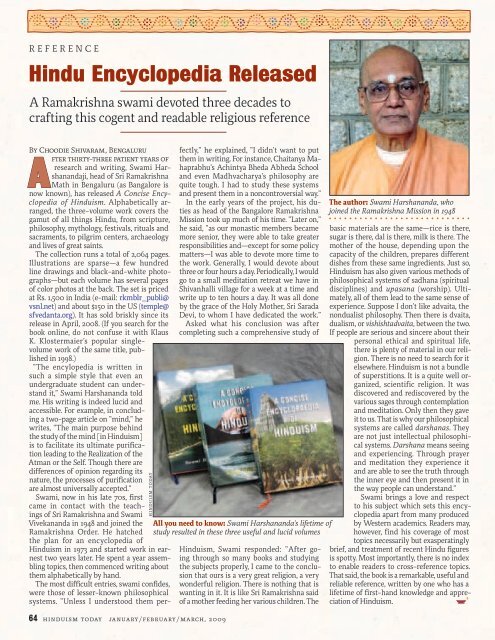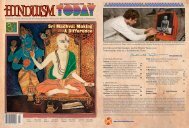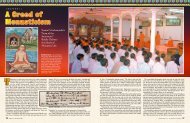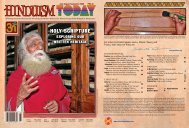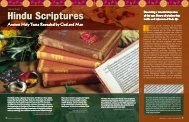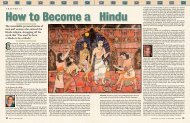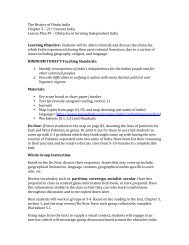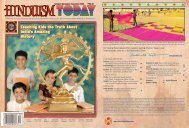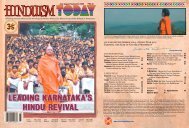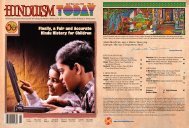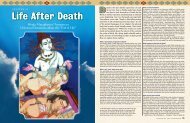Hinduism Today January 2009 - Cover, Index, Front Articles
Hinduism Today January 2009 - Cover, Index, Front Articles
Hinduism Today January 2009 - Cover, Index, Front Articles
Create successful ePaper yourself
Turn your PDF publications into a flip-book with our unique Google optimized e-Paper software.
eferenceHindu Encyclopedia ReleasedA Ramakrishna swami devoted three decades tocrafting this cogent and readable religious referenceBy Choodie Shivaram, BengaluruAfter thirty-three patient years ofresearch and writing, Swami Harshanandaji,head of Sri RamakrishnaMath in Bengaluru (as Bangalore isnow known), has released A Concise Encyclopediaof <strong>Hinduism</strong>. Alphabetically arranged,the three-volume work covers thegamut of all things Hindu, from scripture,philosophy, mythology, festivals, rituals andsacraments, to pilgrim centers, archaeologyand lives of great saints.The collection runs a total of 2,064 pages.Illustrations are sparse—a few hundredline drawings and black-and-white photographs—buteach volume has several pagesof color photos at the back. The set is pricedat Rs. 1,500 in India (e-mail: rkmblr_publi@vsnl.net) and about $150 in the US (temple@sfvedanta.org). It has sold briskly since itsrelease in April, 2008. (If you search for thebook online, do not confuse it with KlausK. Klostermaier’s popular singlevolumework of the same title, publishedin 1998.)“The encylopedia is written insuch a simple style that even anundergraduate student can understandit,” Swami Harshananda toldme. His writing is indeed lucid andaccessible. For example, in concludinga two-page article on “mind,” hewrites, “The main purpose behindthe study of the mind [in <strong>Hinduism</strong>]is to facilitate its ultimate purificationleading to the Realization of theAtman or the Self. Though there aredifferences of opinion regarding itsnature, the processes of purificationare almost universally accepted.”Swami, now in his late 70s, firsthinduism todaycame in contact with the teachingsof Sri Ramakrishna and SwamiVivekananda in 1948 and joined theRamakrishna Order. He hatchedthe plan for an encyclopedia of<strong>Hinduism</strong> in 1973 and started work in earnesttwo years later. He spent a year assemblingtopics, then commenced writing aboutthem alphabetically by hand.The most difficult entries, swami confides,were those of lesser-known philosophicalsystems. “Unless I understood them perfectly,”he explained, “I didn’t want to putthem in writing. For instance, Chaitanya Mahaprabhu’sAchintya Bheda Abheda Schooland even Madhvacharya’s philosophy arequite tough. I had to study these systemsand present them in a noncontroversial way.”In the early years of the project, his dutiesas head of the Bangalore RamakrishnaMission took up much of his time. “Later on,”he said, “as our monastic members becamemore senior, they were able to take greaterresponsibilities and—except for some policymatters—I was able to devote more time tothe work. Generally, I would devote aboutthree or four hours a day. Periodically, I wouldgo to a small meditation retreat we have inShivanhalli village for a week at a time andwrite up to ten hours a day. It was all doneby the grace of the Holy Mother, Sri SaradaDevi, to whom I have dedicated the work.”Asked what his conclusion was aftercompleting such a comprehensive study ofAll you need to know: Swami Harshananda’s lifetime ofstudy resulted in these three useful and lucid volumes<strong>Hinduism</strong>, Swami responded: “After goingthrough so many books and studyingthe subjects properly, I came to the conclusionthat ours is a very great religion, a verywonderful religion. There is nothing that iswanting in it. It is like Sri Ramakrishna saidof a mother feeding her various children. TheThe author: Swami Harshananda, whojoined the Ramakrishna Mission in 1948basic materials are the same—rice is there,sugar is there, dal is there, milk is there. Themother of the house, depending upon thecapacity of the children, prepares differentdishes from these same ingredients. Just so,<strong>Hinduism</strong> has also given various methods ofphilosophical systems of sadhana (spiritualdisciplines) and upasana (worship). Ultimately,all of them lead to the same sense ofexperience. Suppose I don’t like advaita, thenondualist philosophy. Then there is dvaita,dualism, or vishishtadvaita, between the two.If people are serious and sincere about theirpersonal ethical and spiritual life,there is plenty of material in our religion.There is no need to search for itelsewhere. <strong>Hinduism</strong> is not a bundleof superstitions. It is a quite well organized,scientific religion. It wasdiscovered and rediscovered by thevarious sages through contemplationand meditation. Only then they gaveit to us. That is why our philosophicalsystems are called darshanas. Theyare not just intellectual philosophicalsystems. Darshana means seeingand experiencing. Through prayerand meditation they experience itand are able to see the truth throughthe inner eye and then present it inthe way people can understand.”Swami brings a love and respectto his subject which sets this encyclopediaapart from many producedby Western academics. Readers may,however, find his coverage of mosttopics necessarily but exasperatinglybrief, and treatment of recent Hindu figuresis spotty. Most importantly, there is no indexto enable readers to cross-reference topics.That said, the book is a remarkable, useful andreliable reference, written by one who has alifetime of first-hand knowledge and appreciationof <strong>Hinduism</strong>.∏πbook reviewsIndia’sWomenBy Tara Katir, Washington, USAStephen Huyler is well known to usfrom his previous books on India:Village India, Gifts of Earth, MeetingGod—Elements of Hindu Devotionand Painted Prayers. His newest book,Daughters of India—Art and Identity, is visuallybeautiful, emotionally sensitive andan intelligent look into the everyday lives oftwenty Indian women, of several religionsand living in various locations throughoutIndia and abroad.Huyler writes, “The women of India havelong been misperceived in the West. Abusetowards women pervades Indian society, asit does in many parts of the world, but thisabuse must be regarded with its own context.Much of Western reportage about Indianwomen is misinformed or misguided, depictingall or most of them as victims. Terribleinequities within Indian society mustbe addressed and changed, but it is essentialthat Indian women also be recognized fortheir strengths and for the phenomenal abilitiesto rise above adversity. India’s culturesare contradictory—a fact epitomized by theconflicting attitudes towards women.”Huyler’s work is an attempt to correct theseSwami Prakashananda’sbook Baba Muktananda—ABiography looksinto the life of an extraordinaryhuman being. SwamiMuktananda Paramahamsa,affectionately called Baba by hisdevotees, was known by millionsworldwide at the time of hisMahasamadhi in 1982. SwamiPrakashananda has written acompelling portrait of this saintlysoul. From his mother’s devoutprayers at the Manjunath SivaTemple in Mangalore, South India,seeking Siva’s Grace for a child, to Baba’sworld travels, Swami provides us an intimatelook into the life of this modern-day saint.Baba was born May 16, 1908. By the ageof 15 he had frequently seen the sadhuNityananda, who lived an austere life in theKadri Hills of South India with a sect of Nathayogis. An intense face-to-face meetingmisrepresentations while giving a voice tosome of India’s five hundred million women.Through their words and his amazing photographs,he has captured their strength andprofound dignity. Some may view the storiesand see these women as victims. However,Mr. Huyler says, “The chapters are not profilesof victims, but of women demonstratingstrength, fortitude, dignity and spirit.” Completewith full color photographs, Daughtersof India is an extraordinary look into theirlives. This book should help to bring understandingand respect to the most significantpart of Indian society today, her women.daughters of india—art and identity,abbeville press publishers (www.abbeville.com), 137varick st., new york, new york 10013, pgs 263, $65.00A Biography of Muktanandatook place in 1923, changingthe course of Baba’s life. Adeep yearning for a life of spiritualitytook precedence, andhe left home forever to pursuean inner journey.Swami’s account of Baba’searly life is interspersed withamazing stories of Nityananda,(who would become Baba’sguru) life at Ganeshpuri, andBaba’s travels throughout Indiaand the United States.Included in this marvelousbiography are many preciousblack and white photos of Baba and his guru,Nityananda.Baba’s spirituality inspired thousands ofpeople. Through Swami’s book, that darshancontinues to flow to the worldbaba muktananda—a biography by swami praka shananda,sarasvati productions, 1625 hollingsworth dr., mountainview, ca 94040. e-mail: email@sarasvatiproductions.com382 pgs, $23.95Gifts of theHarappansWe come now to an archeologicalstudy that showcases the ingenuity,creativity, science and technologyof the past: Harappan Architectureand Civil Engineering by Jagat Pati Joshi. TheHarappan civilization flourished during the3rd and 2nd millennia bce, reaching its peakaround 2600, shortly after the developmentof Mesopotamia and Egypt.Professor Joshi writes, “Like the other OldWorld Civilizations, the Harappan civilizationseems to have grown from the skillfulutilization of the fertile river systems andtheir valleys in the northwestern region ofthe Indo-Pakistan subcontinent. Systematictown planning, fortification of citadel,elaborate drainage system the idea of establishinggranaries and surplus economy,standardization of brick sizes, weights andmeasures, geometric instruments (e.g. rightangles, linear scale and plumb bob) are theprincipal gifts of the Harappans to succeedingcultures. It was the Harappans who gavethe idea of welfare of the workers for thefirst time. Different types of hydraulic architectureis another legacy of the Harappans,besides many others in social, economic andreligious fields.”Illustrated with maps, drawings and photographs,this scholarly study is a fascinatingand long overdue look at this ancient civilization.The Western educational view hasfocused on Mesopotamia and Greece as the“cradle of civilization,” ignoring the larger andequally advanced civilizations in the Indiansubcontinent and China. This biased viewof history is coming to an end. The InfinityFoundation’s support of Professor’s Joshi’sacademic efforts is applauded, as is the workitself, which is available at Amazon.com.harappan architecture and civil engineering by jagat patijoshi rupa & co., 7/16 ansari road, daryaganj, new delhi110 002, india, 218 pgs, $15.1164 hinduism today january/february/march, <strong>2009</strong>january/february/march, <strong>2009</strong> hinduism today 65


